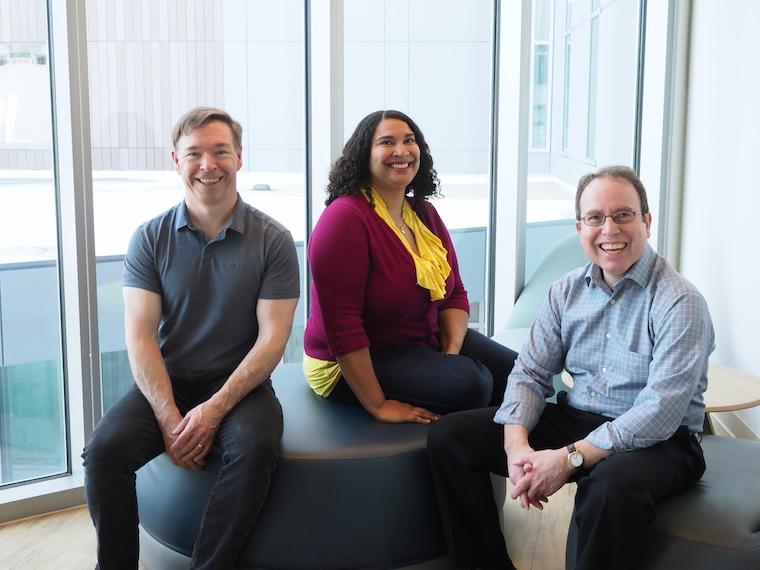Oberlin Center for Convergence (StudiOC)
The Science of Aesthetic Experience
The ability to create and appreciate works of art is both distinctive of human beings and common to all human cultures.

Instructors for the Science of Aesthetic Experience learning community are Todd Ganson, Leslie Kwayke, and Arnie Cox.
Photo credit: Dale Preston ’83
The Science of Aesthetic Experience
Offered spring 2019
The aesthetic dimension of human life is part of what makes us the creatures we are. While interest in the arts is commonplace and familiar, it is theoretically rather puzzling.
Human universals are typically shared because they have adaptive significance for the species, but there is no obvious adaptive value to our preoccupation with the arts. It is also far from obvious what, exactly, differentiates our capacity for aesthetic appreciation from abilities to perceive and feel shared by animals more generally.
For these and other reasons, researchers from a variety of disciplines have sought to shed light on aesthetic experience.
In this course cluster we examine aesthetic experience from an interdisciplinary perspective, drawing on work from psychology, neuroscience, philosophy, linguistics, and musicology. It is an ideal fit for students passionate about both art and science.
PHIL 211 and either MUTH 317 or NSCI 157 required for this learning community.
Instructors
Course instructors for this learning community are Associate Professor of Music Theory Arnie Cox, Assistant Professor of Neuroscience Leslie Kwakye, and Professor of Philosophy Todd Ganson.
Todd Ganson, instructor
Phil 211 Perception and Action
Meets 1:30 pm, Monday, Wednesday and Friday; 4 credit hours; enrollment 30
Required for the Science of Aesthetic Experience StudiOC learning community.
To what extent is the way we perceive the world through the senses shaped by our actions, interests, and goals? Proponents of action-based theories of perception insist that we cannot understand an organism’s sensory perspective without understanding its distinctive form of life—its behavioral adaptations and ecological niche.
In this course, we explore influential action-based theories of perception from Berkeley’s new theory of vision in the 18th century to contemporary “ecological” and “enactivist” approaches to perception.
A section of the course is devoted specifically to aesthetic perception and the Kantian idea that aesthetic engagement is independent of needs and interests.
Leslie Kwakye, instructor
NSCI 157 Neuroscience of the Arts
Meets 1:30 pm, Tuesday and Thursday; 4 credit hours; enrollment 20
Either this course or Music & Embodied Cognition required for the Science of Aesthetic Experience StudiOC learning community.
This course examines the neurological basis of the visual arts, musical arts, and culinary arts. We will heavily focus on the perception of art and how the brain allows us to perceive particular sensory features, experience emotions in response to art, and assign aesthetic appraisals.
We also will discuss the production of art and how neural plasticity allows for the development of expertise. Lastly, the course will evaluate the neurological basis of creativity, improvisation, and imagination.
All scientific knowledge necessary for understanding the material in class will be included; thus, advanced scientific coursework is not required.
Arnie Cox, instructor
MUTH 317 Music & Embodied Cognition
Meets 11 am, Tuesday and Thursday; 4 credit hours; enrollment 20
Either this course or Neuroscience of the Arts required for participation in the Science of Aesthetic Experience StudiOC learning community.
This course examines the relationship between musical experience and conceptualization. Starting from basic embodied experience, we will explore how music generates affective/emotional responses and how these responses motivate and ground concepts and meaning, both traditional and novel, and shared and idiosyncratic.
The approach is interdisciplinary, including readings from or based on perception and cognition (psychology and neuroscience), human development (ontogenetic and phylogenetic), philosophy, cognitive linguistics, musicology (history and theory), and identity performance.
Written coursework includes responses to readings, analysis of music in various styles (Bach, Beyoncé, Balkan, etc.), and a term paper. Familiarity with staff notation is not necessary.